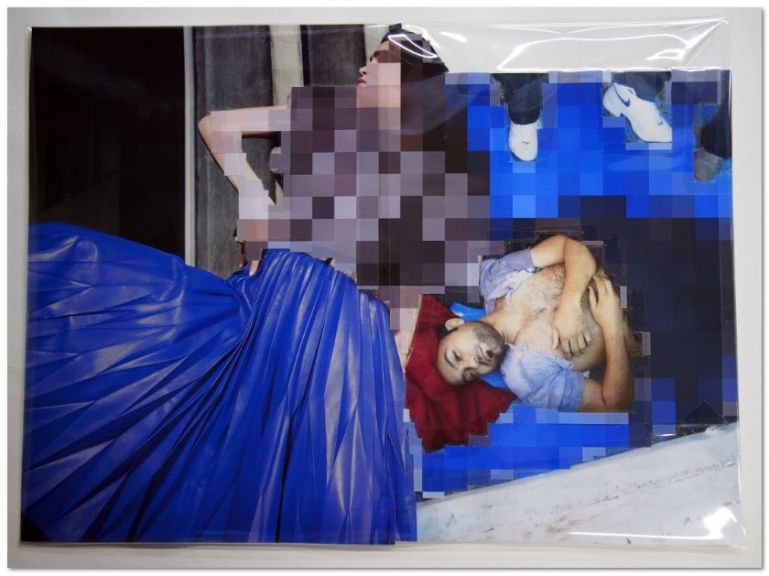
Thomas Hirschhorn, Pixel-Collage n°14, 2015 via Galerie Chantal Crousel, Paris
Photo : Romain Lopez
A recent study has determined that most well-known British artists come from a middle-class background. Critic Ben Davis suggests the same might be the case in the rest of the art world, and asks why we aren’t talking about it. In an art world so often seen as elitist, players—artists and funders alike—are reticent to analyze an artist’s economic background at all. Davis’s hopeful yet cautionary conclusion: “The conspiracy of silence around this subject forestalls thinking constructively about how visual art might actually become the more broadly relevant thing its fans believe it to be.”
- In the eyes of Thomas Hirschhorn, collage means “creating a New World with elements of the Existing World.” In his new series Pixel-Collage, Hirschhorn highlights not the capacity of pixels to create an image, but to obscure one. Exploring the “growing phenomenon of facelessness in pictures being reproduced today,” Hirschhorn highlights the “increase in the use of pixels and blurring by the media as a means of asserting authority.”
- At last, Weiwei has won. Yielding to widespread public criticism for its refusal to sell mass quantities of plastic bricks to Chinese artist Ai Weiwei, Lego has lifted a ban on bulk orders. The company admitted in an official statement that its rules could “result in misunderstandings or be perceived as inconsistent.”
- Most architects aim to create iconic buildings, seeing socially conscious projects as secondary. Chile’s Alejandro Aravena bucks this trend, prioritizing social consciousness in architecture through work that “gives economic opportunity to the less privileged, mitigates the effects of natural disasters, reduces energy consumption, and provides welcoming public space.” The design world has taken note. Last week, Aravena won architecture’s top prize: the Pritzker.
- Strides have been made in ensuring a more racially equitable art world, but there’s still a long way to go. “The biggest lack is diversity in staff in museums,” says Lowery Stokes Sims, who has worked at the Studio Museum, the Met, and the Museum of Arts and Design. “That is really a very stubborn point for which we haven’t had many breakthroughs.” Artsy gathers a group of art professionals to discuss the current challenges and successes of museums in achieving significant diversity.
- “Right now the art world is run by billionaire art collectors who buy art that appeals to their values. We say art should look like the rest of our culture.” Ahead of this week’s launch of their Twin Cities Takeover, the Guerrilla Girls visited with Stephen Colbert. They argue that while white males continue to dominate the art world, the history of art isn’t really a history of art at all. “It’s a history of power.”
- Coco Fusco commemorates the Guerrilla Girls’ 30th anniversary as a collective with a recollection of her “first encounter with a full-on feminist art intervention”: a protest exhibition curated by the Girls at the Palladium in 1985. “The Guerrilla Girls gave me a way to consider taste as a political matter,” she writes. She also notes that their “simian guises upped the ante as far as how to appeal to the public”—so much so that when Fusco was invited to be part of MoMA’s first art and feminism conference in 2007, she was inspired by the collective to don military fatiques.
- Why are there so many great female video artists? Artsy looks at the history of women and video art, from Valie Export to Jennifer Steinkamp. “In video, women found a form free from the male-dominated canon, in much the same way that performance art provided uncharted territory for experimentation.”
Follow Art News From Elsewhere on the Walker Art Center homepage or via @walkermag, the Walker’s editorial-focused Twitter feed.



